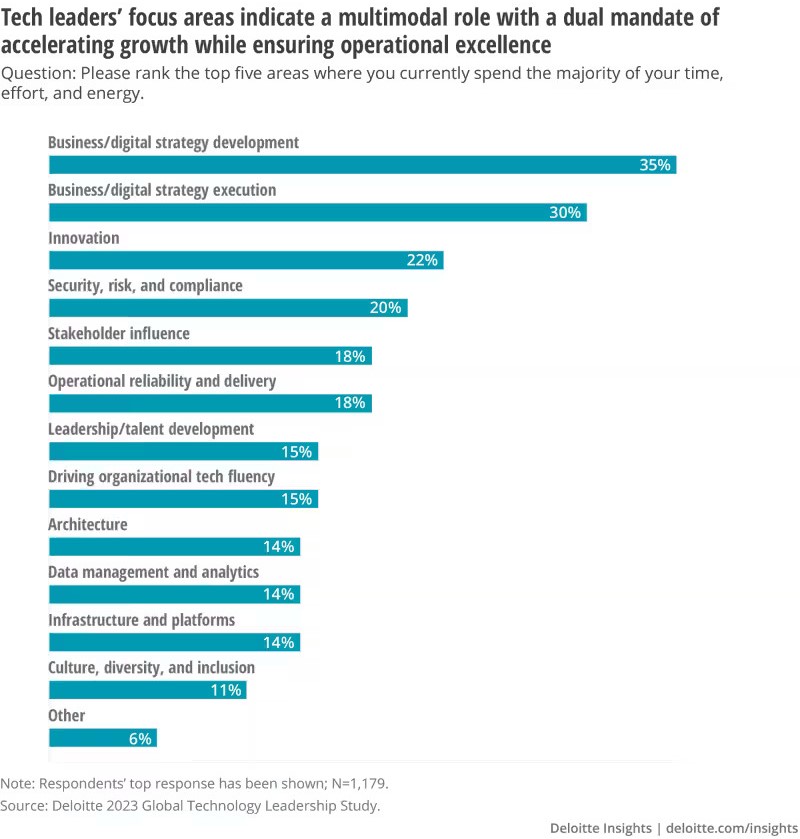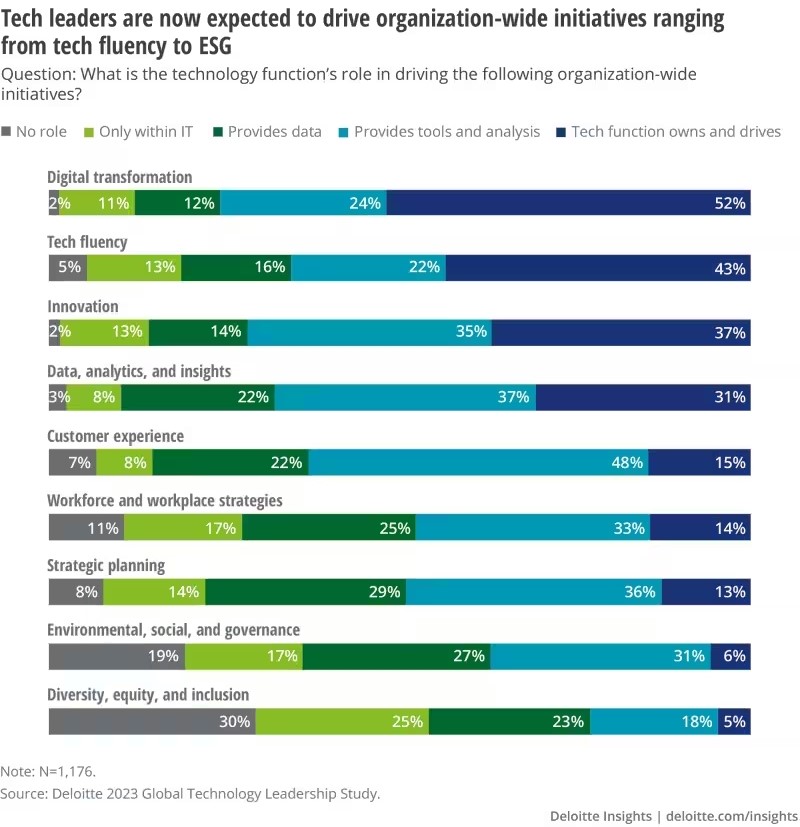In an era where technology permeates every aspect of our lives, organizations face a crucial challenge: finding and hiring the right leaders who can navigate the landscape.
The importance of assembling a stellar team of tech leaders cannot be overstated, as their decisions and expertise can make all the difference in an organization's success or failure.
According to Economic Times, successful technology leaders inspire teams to explore and experiment, fostering continuous learning and adaptability.
In 2023, rapid advancements in artificial intelligence, blockchain, cybersecurity, and other transformative concepts have revolutionized industries and reshaped business strategies. To remain competitive and thrive in this dynamic environment, companies must ensure they have the right leaders who can harness the power of technology and steer them toward continued growth. As a research by Harvard Business Review reveals, digital transformation is less about technology and more about talent. This emphasizes the importance of finding leaders who not only have a deep understanding of cutting-edge tech but also the ability to align them with the company's vision, goals, and market demands.
Staying up to date with the latest hiring strategies and techniques is paramount for organizations aiming to secure top talent. Read on for some key insights.
Also Read: The Recruiter’s Handbook To Hiring In 2023
Assessing Tech Leadership Potential
The necessary and fundamental role of a tech leader today is not the same as it was a few years ago; it has undergone a remarkable transformation. They’re expected to navigate complex challenges, understand and adapt to changing trends, and deliver tangible business outcomes, while also guiding other people to do the same.
However, can one person get so much done?
Hiring tech leaders requires finding the perfect mix of qualities and skills. Here’s what you should look out for.
Deloitte 2023’s Global Technology Leadership Study details 5 competencies that they must possess:
- Engineer: Tech leaders with engineering competencies possess the ability to build, operate, and optimize business operations and technology capabilities. They bring deep operational expertise, technical acumen, and a strong commitment to creating operational value. Their primary responsibility lies in maintaining technology applications and infrastructure to ensure efficiency, effectiveness, and security within the organization.
- Architect: A tech leader with architectural competencies can envision, design, and oversee technology environments to ensure resilience, scalability, and agility. They stay ahead of new and emerging technologies, continuously exploring and experimenting to keep their organizations competitive.
- Data Scientist: Leaders with data science competencies are adept at collecting, managing, and analyzing data to deliver valuable insights and identify opportunities for monetizing tech assets, thereby driving business growth. Their expertise lies in leveraging data to make informed decisions and uncover actionable intelligence.
- Change Agent: Tech leaders with change agent competencies excel at instigating, managing, and delivering large, complex digital transformations throughout the enterprise. They drive value by transforming business processes, employee and customer experiences, and overall business operations. Their role involves effectively navigating change and ensuring the successful implementation of transformative initiatives.
- Owner: Particularly at the business-unit level, tech leaders should possess deep business acumen and strong stakeholder relationships. This enables them to proactively identify challenges and create innovative solutions.
As mentioned above, it’s not only the competencies. Here are some essential qualities and skills that are a ‘must’ for a tech leader.
- Technical Expertise: A study conducted by Harvey Nash and KPMG found that 72% of HR professionals consider technical skills and knowledge as the most critical competency for tech leaders.
- Strategic Thinking: Tech leaders should identify opportunities where technology can create a competitive advantage and drive revenue growth; this can contribute to long-term success and help future-proof their organizations.
- Adaptability: The ability to embrace change and lead teams through transformations is critical. Tech leaders need to stay current with the latest trends, anticipate disruptive forces, and swiftly adapt their strategies.
- Team Management and Collaboration: According to the Harvey Nash/KPMG Survey 2020, 70% of technology leaders felt that crisis increased the collaboration between them and their teams. Thus, HR needs to evaluate whether or not one can assemble high-performing teams and harness the collective genius- not only when the situation is good, but also when all goes south.
For more information, read this interesting article by The Enterprisers Project on 4 examples of successful IT leadership.
Innovative Hiring Approaches
We’ve said it before and we’ll say it again- traditional hiring approaches are not going to cut it any longer! With the way the world is evolving and the speed at which roles are transforming, HR must embrace modern hiring techniques if they intend to attract, hire, and retain niche skills or important leadership positions.
Utilize behavioral interviews which delve beyond technical skills, focusing on a candidate’s behavior, problem-solving abilities, and decision-making processes. Incorporating simulations or role-playing exercises specific to the tech leadership role can provide valuable insights into how candidates approach real-world scenarios. This is the perfect way to assess competencies in action, enabling better prediction of their performance within the organization. Be sure to incorporate assessments that focus on understanding their emotional intelligence, communication skill, adaptability, and leadership qualities as well.
Hackathons and technical challenges are also a great way to be sure of a candidate’s prowess and past experience, and allow you to better decide the compensation structure too. Leverage AI and data analytics to provide insights into how effective these hiring strategies are and continuously use the feedback to refine processes and identify areas of improvement.
However, all this could ultimately be in vain if you don’t stop to think about the cultural fit. Candidates applying for a tech leadership position are most likely to be extremely skilled and experienced, but that doesn’t mean all would be the perfect match for your particular organization. Assessing culture fit is essential to ensure long-term success and team cohesion, which can be done through value-based interviews or team-based exercises.
Inevitably, once you refine your hiring process to incorporate these strategies, you’ll find that your organization attracts and manages to hire the cream of the crop talent for your tech leadership position; but what about retention?
Nurturing Growth And Retention
Recognizing the value that these leaders bring to the table and the critical role they play in driving innovation and achieving business goals, organizations must prioritize strategies that nurture their professional growth, ultimately leading to a long-term association. Tech leaders possess invaluable institutional knowledge, experience, and expertise, and their departure can lead to significant knowledge gaps and disrupt the organization's momentum. Retention efforts not only ensure the retention of key talent but also contribute to employee morale, productivity, and success.
- Ongoing Support and Mentorship: Even leaders need mentorship! Invest in experienced professionals that can provide guidance, share industry insights, and act as a sounding board for ideas and challenges. Regular check-ins, one-on-one meetings, and coaching sessions create a supportive environment that fosters personal and professional growth.
- Opportunities for Skill Development: Tech leaders thrive on continuous learning and professional development. Providing opportunities for skill enhancement, such as training programs, workshops, conferences, and access to online resources, not only helps them stay updated with the latest technological advancements but also enhances their leadership capabilities.
- Continuous Feedback and Performance Evaluations: Constructive feedback helps professionals understand their strengths and areas for improvement. Implementing a robust performance evaluation system that considers both technical and leadership competencies can provide a clear roadmap for their growth and development. It’s also a great way to acknowledge their contributions and provide much-needed recognition.
As the competition intensifies and tech continues to become more complex and daunting, the stakes have never been higher, and the need for a reliable and efficient solution takes priority. That’s where we come in.
Global Talent Exchange is revolutionizing the way organizations approach leadership hiring. With an extensive network spanning more than 30 hubs worldwide, we have established ourselves as the go-to platform for connecting organizations with top-tier tech talent. Our unparalleled reach and expertise enable us to match organizations with the right professionals who possess the critical competencies, skills, and experience needed.
Schedule a consultation to discover the new avenues of growth and success that we can help you unlock.











